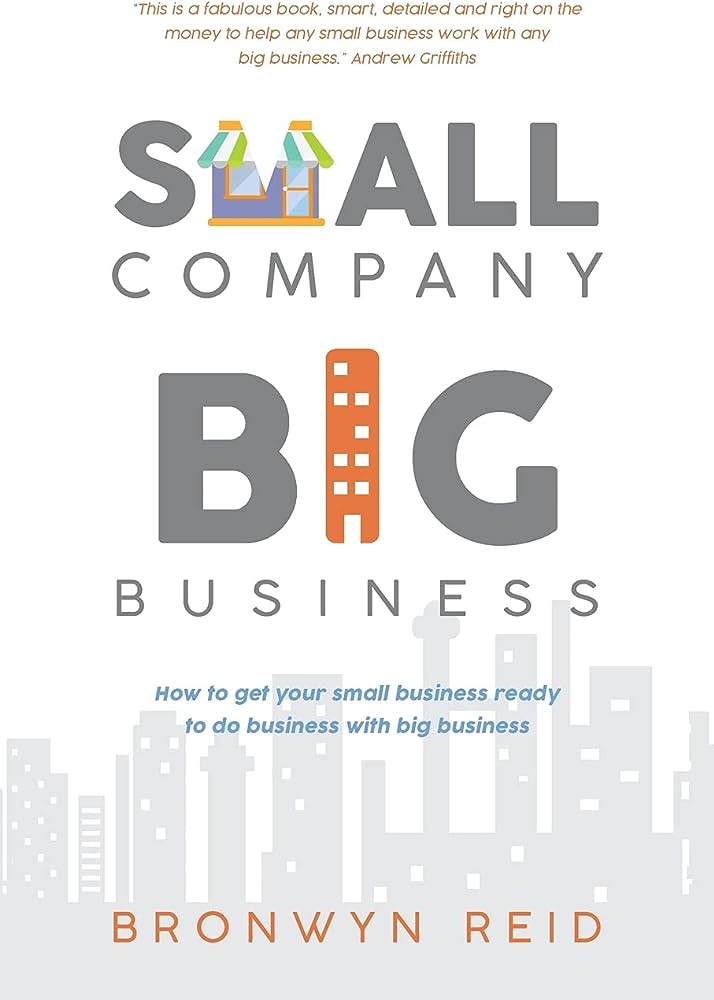In Small Company Big Business: How to get your small business ready to do business with big business, Small Business | Big Business Relationship counsellor Bronwyn Reid describes the five essential steps for attracting and retaining buyers as customers – whether they be national or international companies, Government, or even large Not For Profits.
The Three Disconnects
Complexity
Big companies and government have a whole raft of “prerequisites” that must be put in place before they will deal with you, and they can change all the time. Sometimes they seem to not even know what they want themselves. In this confusing environment, it is very hard for the small business owner to figure out exactly what is required of them.
Cost and Time
Implementing all the “prerequisites” and making the necessary changes to your business is a time-consuming and costly exercise. And then you have to keep everything up to date. All this requires a considerable amount of dollars, time, and energy. For some, it’s all just too much and they walk away. For those who accept the challenge, putting it all in place can take years, and a lot of time and money can be wasted trying different solutions.
Getting “on the radar”.
Most small businesses struggle to get “on the radar” of large corporations, and get a foot in the door.
Supply Chain
The supply chain is a cascading series of transactions that end with the final consumer receiving the goods or services they required. As with any chain, if one link breaks, the entire chain fails. The big company doesn’t get their required products or services, so they can’t supply their customers, who in turn become very, very unhappy.
“The first step in understanding how big buyers buy is to understand the concept of a ‘supply chain’, and that you are just one, small link in that chain”.
Risk Management
These organisations may have billions of dollars at stake, so they try to ensure that every single company and person in that long supply chain knows exactly what their job is, and that they can do it properly, safely, and continuously. That is why supplying to large organisations requires a lot more work and preparation than supplying to most other customers—they want to reduce their RISK. Big organizations hate risk. Their priority is to eliminate risk from their supply chain.
Elements of a Contract
Essentially, there are five elements to a legally binding contract:
1. Offer and Acceptance – You have products and services on offer. Your Offer is accepted when the Buyer sends you a Purchase Order and you agree to do the work/supply the services according to the Terms and Conditions (Acceptance).
2. Intention to create a legal relationship – Offering to take your neighbour’s bin out while they’re on holiday has an offer and acceptance, but it is not intended to create a legally binding relationship. In a business setting however, your Terms and Conditions will make that clear.
3. Consideration – Money or some value will be exchanged be- tween the parties.
4. Capacity to contract – Both parties to the contract are free to enter into the contract. This is rarely a consideration, but can introduce some problems if there is a bankruptcy involved or the person signing the contract is not authorised to act on behalf of the company.
5. Consent – The contract must be understood and consented to by both parties. This is the area that can create diffi- culties because of the power difference between the big buyer and you, the small business owner.
Your External Team
Being a small business owner is a team sport, and you need a professional team to support you. At a minimum, you need:
• An accountant
• A banker
• A lawyer
• An insurance broker
Systems, Processes, Tasks, and Procedures
Each System is made up of a number of Processes. Using the Finance System as an example, there is a process to pay bills, a process to receive payments, a process to create invoices … For each Process, there will be a number of Tasks. For every one of these Tasks, there will be a Procedure that documents how that Task should be done.
Capability Statement
A Capability Statement is a cross between a company brochure and a business card on steroids. In short, it tells your prospective client exactly what you and your company are capable of doing—your capabilities. On occasion, you will see them referred to as a Business Profile, or even Corporate Credentials.
Bids, Tenders, Proposals
Tendering is a process whereby a buyer specifies what goods and/or services it needs, and then asks potential suppliers to submit a response by a set date, outlining how they will meet the requirements, and how much their solution will cost. The buyer issues a Request For Tender (RFT).
The Tender process is used when the buyer is sure (or at least they think they are sure) about exactly what they want. The tender documents will contain specifications of what goods or services are required, and any standards or qualifications that have to be met. In short, the scope of work and the deliverables expected will be quite clear and specific.
Request for Proposal (RFP)
RFP will outline the problem and the desired outcome, and the potential sup- pliers are invited to come up with a solution. In other words, the RFP concentrates on the end, not the means.
Your response to an RFP is not constrained by specified forms and documents to complete (although there may be some). To present your unique solution, you have complete freedom in how your response is structured.
All the Best in your quest to get Better. Don’t Settle: Live with Passion.



Comments are closed.